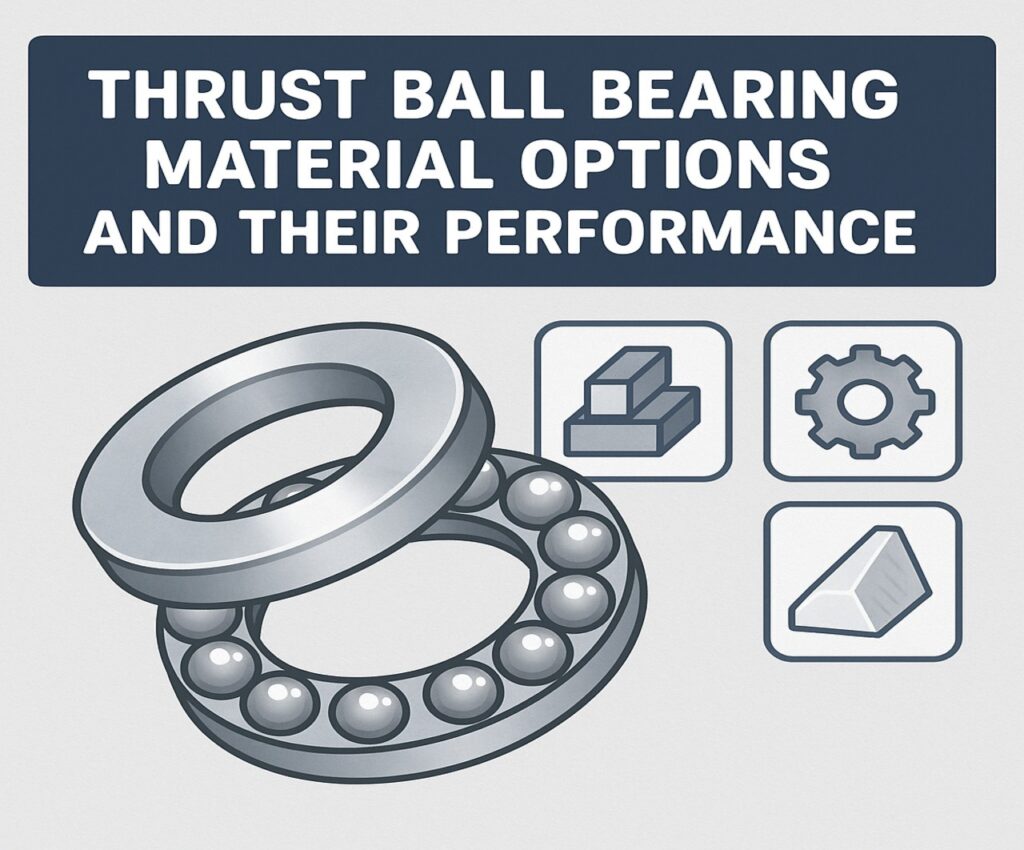In the world of high-performance machinery and precision components, sealed thrust bearing, roller thrust bearing, and thrust bearing manufacturers are three of the most searched terms. And for good reason. Thrust ball bearings play a pivotal role in managing axial loads in everything from electric motors to aerospace systems. But the material you choose for these bearings can make or break your machine’s performance, longevity, and reliability.
Understanding the strengths and weaknesses of different thrust ball bearing materials is essential for selecting the right bearing for your application. From high-speed electric motors to heavy-duty gearboxes, the material impacts every aspect of bearing performance. Let’s explore the leading material options, compare their performance, and identify how sealed thrust bearing, roller thrust bearing, and reputable thrust bearing manufacturers are adapting to evolving industrial demands. Know More
1. Chrome Steel (AISI 52100)
The most common material used by thrust bearing manufacturers is chrome steel. Known for its high hardness and excellent wear resistance, AISI 52100 steel is a top choice for standard applications.
Performance Advantages:
- High load capacity
- Excellent fatigue resistance
- Cost-effective
Limitations:
- Not corrosion resistant
- Requires regular lubrication
Ideal for:
- Automotive transmissions
- Machine tool spindles
- General industrial use
Sealed thrust bearing models made from chrome steel are often preferred in clean environments where moisture and contamination are minimal.
2. Stainless Steel (AISI 440C)
For applications exposed to moisture, chemicals, or washdowns, stainless steel is the go-to material. Many thrust bearing manufacturers offer sealed thrust bearing models made from AISI 440C to balance corrosion resistance with good mechanical strength.
Performance Advantages:
- Corrosion resistant
- Durable in harsh environments
- Moderate fatigue strength
Limitations:
- Slightly lower hardness than chrome steel
- More expensive
Ideal for:
- Food processing equipment
- Marine applications
- Cleanroom machinery
Roller thrust bearing versions made of stainless steel are often used in medical devices and pharmaceutical equipment.
3. Ceramic Hybrid Bearings
A rising star among thrust bearing manufacturers is the use of ceramic hybrid bearings. These consist of ceramic balls (usually silicon nitride) and metal races, offering a unique combination of lightweight and high-speed capabilities.
Performance Advantages:
- Extremely low friction
- Can operate with minimal lubrication
- Electrical insulation properties
Limitations:
- High cost
- Brittle under shock loads
Ideal for:
- High-speed electric motors
- Aerospace control systems
- Precision instruments
Sealed thrust bearing options with ceramic elements are gaining ground in the EV industry, where high RPM and low maintenance are critical.
4. Polymer and Plastic Bearings
Some thrust bearing manufacturers are turning to engineered plastics and polymer composites for ultra-lightweight, low-load applications. While not suitable for heavy-duty use, they offer unique benefits in niche sectors.
Performance Advantages:
- Lightweight
- Maintenance-free
- Resistant to chemicals and corrosion
Limitations:
- Low load and speed capacity
- Not suitable for high-precision demands
Ideal for:
- 3D printers
- Office automation devices
- Light-duty conveyors
A roller thrust bearing made of polymer may not carry a crane, but it could easily keep a photocopier running quietly for years.
5. Bronze and Brass Cages
While not a rolling element material, the cage or separator in a sealed thrust bearing or roller thrust bearing plays a vital role in maintaining spacing and reducing friction. Bronze and brass are frequently used for their self-lubricating qualities and durability.
Performance Advantages:
- Excellent wear resistance
- Naturally lubricating
- Stable at high temperatures
Limitations:
- Adds to overall bearing cost
- Not ideal for corrosive environments
These materials are popular in roller thrust bearing setups used in gearboxes and rotating industrial equipment.
Comparing Performance by Application
Let’s break down how these materials perform in real-world environments:
| Application | Recommended Material | Why? |
| Food & Beverage Equipment | Stainless Steel | Corrosion-resistant and easy to clean |
| High-Speed Electric Motors | Ceramic Hybrid | Low friction, high-speed performance |
| General Industrial Machinery | Chrome Steel | Durable, cost-effective |
| Office Automation | Polymer | Quiet, maintenance-free |
| Marine Systems | Stainless Steel or Brass Cages | Resists moisture, long-lasting |
Sealed vs. Open Bearings: A Material Perspective
Sealed thrust bearing models are becoming more popular across industries. Why? Because sealing helps retain lubricant and exclude contaminants, extending the life of the bearing. This is especially important when using chrome or stainless steel.
While roller thrust bearing setups are often open due to their need for higher load capacity and larger space requirements, many thrust bearing manufacturers now offer sealed versions even for heavy-duty needs.
Material Tip: The choice of seal material (rubber, PTFE, metal shields) should align with the rolling element material and application environment.
The Future of Thrust Bearing Materials
The future looks bright for innovation. Leading thrust bearing manufacturers are exploring nanocomposite coatings, advanced ceramics, and hybrid structures to push the limits of durability and speed.
Expect to see more smart sealed thrust bearing designs that integrate condition-monitoring sensors. Imagine a roller thrust bearing that alerts you when it needs lubrication or is approaching wear limits. That’s where material science and IoT are converging.
Some startups are even developing biodegradable polymers for single-use or low-impact environments—eco-friendly solutions with surprising performance capabilities.
Final Thoughts
The material of a sealed thrust bearing or roller thrust bearing matters more than ever. With more specialized applications, extreme environments, and performance demands, choosing the right material is as critical as choosing the right size or type.
Top thrust bearing manufacturers offer a wide range of material options, each suited to specific needs. Whether you’re dealing with high-speed turbines or saltwater pumps, there’s a material configuration tailored for your exact challenge.
Make your choice count. A well-selected bearing material can boost efficiency, extend service life, and prevent unexpected breakdowns.

